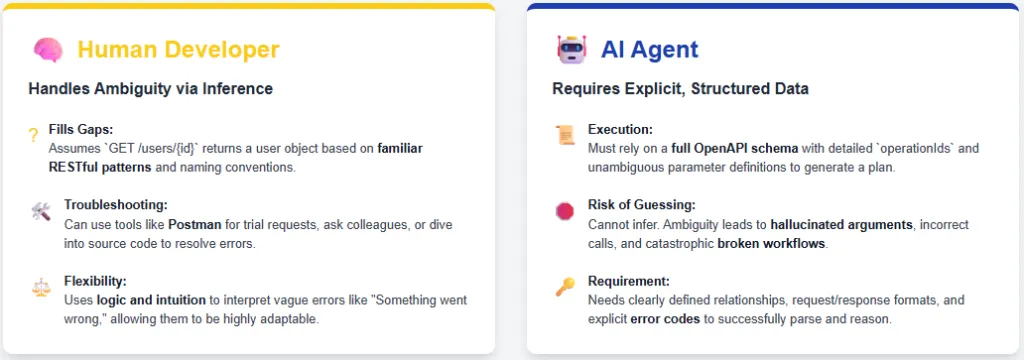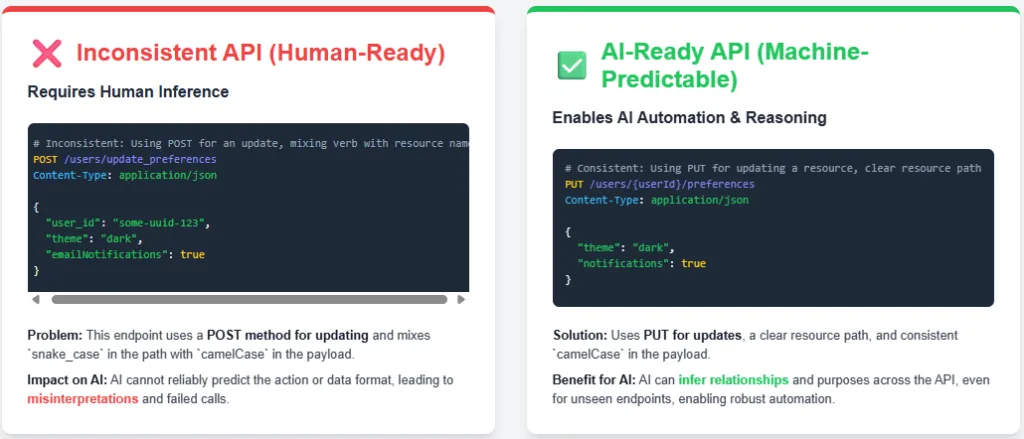How to build AI-friendly APIs?

Postman recently released a comprehensive checklist and developer guide to building the right APIs, highlighting a simple truth: even the most powerful AI models are only as good as the data they get – and that data comes through your API. If your endpoints are inconsistent, unclear, or unreliable, demoly models correct bad input instead of generating insight. Postman's Playbook lays out years of actionable steps that help teams make their APIs predictable, machine-readable, and reliable for AI work.
This document summarizes the key ideas in that playbook. As we move to a world where agents – not humans – will shop, compare options, and interact with services, APIs must emerge. Unlike developers, agents cannot compensate for dirty documents or difficult behavior. They rely on common patterns and are automatically generated, automated documents that always conform to your schema. The goal is simple: Create APIs that humans and AI Agents can instantly understand, so your programs can scale smarter and unlock their full potential.
Inactive metadata mechanism
Humans can enter information that is missing from dead APE documents, but AI ADER CANNOT rely entirely on clear, machine-readable metadata. Instead of “This endpoint returns the user preferences“AI-Ready API must describe everything: Request type, parameter schema, response structure, and object definitions. Clear Metadata as the example above removes, and makes APIs well understood by machines.



Errors are rich in semantics
Developers can interpret clear errors such as “Something went wrong“But AI Agents can't – they need specific, structured guidance. APIs are ready to clearly define what failed, why it failed, and how to fix it. Error rich metadata with fields like summary, sent word, expectedagain – known It removes the guesswork and empowers agents to be prepared instead of caught.


Cognitive skills
For APIs to be ready for you, they must go beyond Human-Centric, clear documentation. Unlike engineers who can enter missing information using context and sit, AI agents are completely dependent on structured data to plan and execute. This means that APIs must provide a complete specification with a complete schema, clearly defining all endpoints, parameters, data schemas and error codes. Without this clarity, AI systems are forced to guess, which in turn leads to vehicular traffic and untrustworthy, unethical behavior.


Amazing composition patterns
AI programs rely on consistent patterns, so predictive conventions make your API much easier for them to understand and navigate. Where Empopoints and fields follow clear, uniform structures such as appropriate relaxation methods and casing-ai constants without relation and behavior without assuming function. This reduces ambiguity and enables more accurate automation, reasoning, and integration across your API.


Unpredictable Behavior
Agents ai need strict flexibility – the same should generate the same layout, format, and fields. Humans can solve problems with counterintuitive answers using intuition, but AI cannot think or investigate; It only learns from the patterns you provide. If there are shouts, nests, or errors that vary across agents, the agent becomes unreliable or completely broken. To be fair, your API should provide transparent responses, uniform naming, consistent error handling, and hidden cases. In short: inconsistent inputs lead to inconsistent agent behavior.


Relevant Documents
Humans can look things up when the documentation isn't clear, but ai agents can't – they only know what your API specifically tells them. Without clear, complete documentation, the agent cannot find empveints, understand parameters, predict responses, or recover from errors. Beautiful scripts aren't the only choice for the right API for AI—they're the only way agents can reliably learn and interact with your system.
Reliable and fast
AID AGENTS AST as Orchestrators, quickly make quick and consistent calls – so your API speed and reliability directly impact their performance. People can wait for slower responses or manually retry, but agents will log out, fail, or break the entire workflow. With fast, automated environments, an AI system is only as strong as the APIs it depends on. If your API can't keep up, neither can your ai.
Availability
Humans can track down missing apis through wikis, discussions, code, or intuition—but AI Agents can't. If an API isn't well-published with structured, searchable metadata, it simply doesn't exist for them. AI programs rely on specs, available specs and examples to understand how to use the API. Making your API visible, accessible and well served by platforms like the Postman API Network ensures that both developers and agents can reliably find you.

I am a civil engineering student (2022) from Jamia Millia Islamia, New Delhi, and I am very interested in data science, especially neural networks and their application in various fields.
Follow Marktechpost: Add us as a favorite source on Google.



